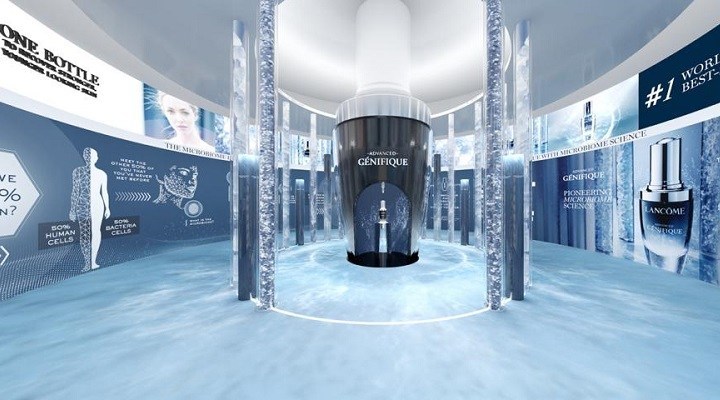Six months after debuting its virtual flagship pop-up in Singapore, Lancome is bringing the immersive 3D shopping experience to Australia.
Launching this Thursday, February 11, and running for two weeks, the virtual pop-up aims to educate customers about the science behind the brand’s best-selling anti-aging serum, Advanced Génifique, and inspire them with talks from local and international personalities about health and well-being, female empowerment and tech and engineering.
There’s also an opportunity to receive a personal skin diagnosis from a Lancome beauty advisor in real time, explore customer testimonials and, of course, buy the product.
In a statement about the pop-up, Lancome said it was “pushing the boundaries of innovation and […] merging the world of beauty with technology and engineering — something we are proud to pioneer on a global level and are now executing here in Australia”.
Rise of virtual stores
Part of L’Oreal’s luxury portfolio, Lancome is just the latest brand to launch a virtual flagship. British beauty brand Charlotte Tilbury opened its Beauty Secrets virtual flagship last December and luxury brand Tumi unveiled a virtual store for customers in APAC and the Middle East last week.
And it’s not just beauty and luxury brands that are opening virtual stores. Obsess, the agency that built Charlotte Tilbury’s virtual flagship, told Inside Retail it was also working with telecom and big-box retailers.
Dr Jason Pallant, a senior marketing lecturer at Swinburne University of Technology in Melbourne, attributes this to the impact of Covid-19 on consumer behaviour.
“The Covid pandemic clearly showed the need to offer ways for consumers to engage with a brand and its products outside of physical locations. However, this trend has been evolving even before the pandemic where consumers increasingly want to shop wherever, whenever, and however they want,” he told Inside Retail. “Virtual stores can be a key part of a retail mix to satisfy that need.”
Unlike e-commerce sites, virtual flagships aim to provide the same sort of immersive shopping experience as bricks-and-mortar stores. So, rather than clicking on static product images arranged in a grid on a website, customers navigate a 3D virtual space and discover products in context.
But as with all forms of technology, there can be downsides, particularly if the experience is not designed and managed well, according to Pallant.
“The success of a virtual store will come down to the strategy behind it. Is it there to help consumers who would otherwise shop online see products in a virtual setting? If so, the store should have similar components of easy checkout, seamless flow through the store, et cetera. However, if it’s a way to engage consumers with a brand as a more experiential experience then it’s about trying to make the store as immersive as possible,” he said.
For Matt Newell, partner and CEO of Sydney-based retail consultancy The General Store, virtual stores can’t just replicate an existing shopping experience online. They need to add something more.
“The opportunity for [virtual retail] is to create a heightened shopping experience, not just to replicate a real shopping experience,” he told Inside Retail.
“VR gaming shows the potential to create the sensation of flying through a city, meeting people from other corners of the globe, or being immersed in fantastical environments. The potential is limitless, but retailers approach it with a bricks-and-mortar mindset, which is highly limiting.”
Lancome’s virtual pop-up, with its focus on adding value through personalised skin diagnoses and connecting customers with celebrities and influencers, is a “step in the right direction”, according to Newell.






